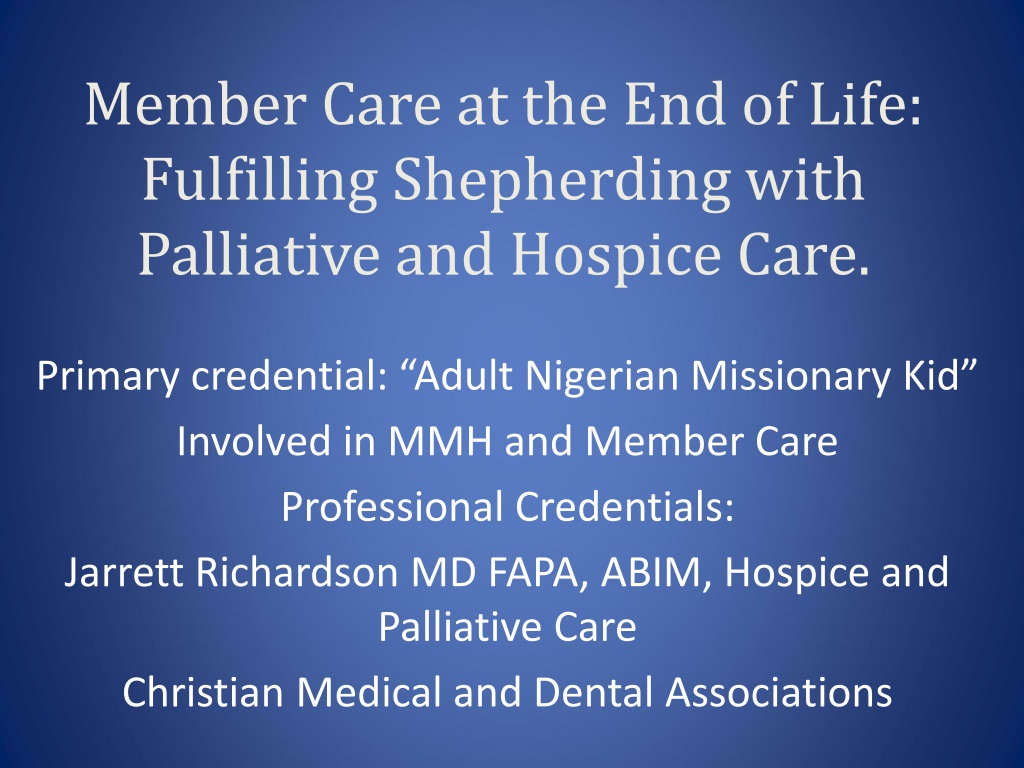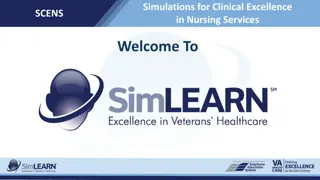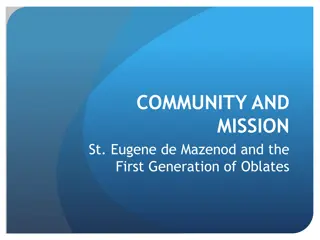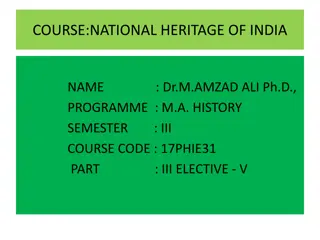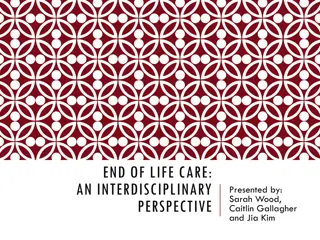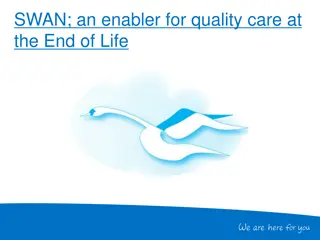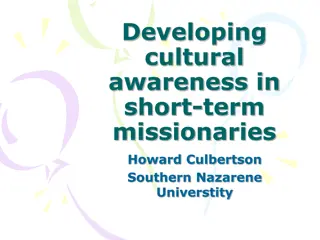Shepherding Missionaries at End of Life
Fulfilling member care at the end of life for missionaries involves providing holistic support, from recruitment to retirement. This comprehensive approach includes partnering with churches, assessing candidates, offering training, ensuring adequate compensation, and guiding missionaries through the entire lifecycle. The focus is on compassionate care, preparation, and supporting missionaries through all stages of their service.
Download Presentation

Please find below an Image/Link to download the presentation.
The content on the website is provided AS IS for your information and personal use only. It may not be sold, licensed, or shared on other websites without obtaining consent from the author.If you encounter any issues during the download, it is possible that the publisher has removed the file from their server.
You are allowed to download the files provided on this website for personal or commercial use, subject to the condition that they are used lawfully. All files are the property of their respective owners.
The content on the website is provided AS IS for your information and personal use only. It may not be sold, licensed, or shared on other websites without obtaining consent from the author.
E N D
Presentation Transcript
Member Care at the End of Life: Fulfilling Shepherding with Palliative and Hospice Care. Primary credential: Adult Nigerian Missionary Kid Involved in MMH and Member Care Professional Credentials: Jarrett Richardson MD FAPA, ABIM, Hospice and Palliative Care Christian Medical and Dental Associations
Member Care at the End of Life February 21, 2015 Jarrett Richardson MD 1. Defining the Issues: a. Models of Care- Life Cycle, Bio/Psycho/Social/Spiritual b. Epidemiology- Health at retirement, aging, end of life, 2. One Approach: Anne Noble SIM ministry -needs and resources 3. Understanding The Palliative/Hospice Model/Philosophy 4. Discussion 5. Resources:
Too Valuable to Lose: Exploring the Causes and Cures of Missionary Attrition edited by William D. Taylor Individual, Family, Team, Organization, Partnerships have life cycles The Unattached young Adult The Newly Married Couple The Family With Young Children The Family with Adolescents Launching Children and Moving On The Family in Later Life Author: O'Donnell, K. Helping missionaries grow: Readings in mental health and missions (pp. 148-163)
Missionary Lifecycle Shepherding . We are committed to a holistic model of caring for missionaries, from start to finish. To that end, we: Partner with a network of like minded churches and pastors Recruit missionaries by pastoring prospects, not persuading them Assess candidates with wisdom and compassion Utilize a well developed pipeline to move missionaries from short term to long term service Shepherd missionaries closely through the fund raising process Provide a compensation and benefits package fully adequate to support long-term service Ensure thorough pre field preparation and training Nurture deployed missionaries with high quality member care; Assist in the re-entry process at the end of a term of service, and Employ a seasoned staff of experienced missionaries committed to training others.
Retirement What Missionaries Ought to know about Retirement http://www.missionarycare.com/brochures/br_retirement.ht m Where will I live? Will I have enough money? What will I do? Who will be my friends? Special Considerations.
Missionary Life Cycle With a Sending Organization-JWR Dating [Exploration of a call] Engagement [Application process] Marriage [Mutual commitment] Deployment [First and subsequent tours ] Re-entry [First and subsequent home assignments] Single or pre-children With children [Married before and with children] With parents [Sandwich generation] Retirement/Removal [Planned and unplanned] Aging [After retirement- may be 30 + years] End of Life [Most common is not sudden death]
Final Stage of Missionary Life Cycle End of Life Little discussion of death and dying in mission circles Little research available Little written on this stage of missionary life Seldom taught in missionary courses or in courses for Churches, Mission Sending Organizations, or Missionary Preparation for..
The Facts Life is still 100% fatal unless the Lord comes first Modern medical care and other factors has extended the life expectancy in the North by 10 years since 1970. The causes of death are shifting toward chronic and degenerative disorders rather than sudden or catastrophic causes Missionaries survive the field in better health than their USA peers, but are not protected from the problems of living longer
78.64 years (2011) United States of America, Life expectancy
Aging Demographics Currently, 35 million Americans 65 & over By 2030, over 69 million Americans 65 & over By 2050, almost 80 million Americans 65 & over By 2050, elderly increase by 115% AAHSA WEBSITE, AGING DEMOGRAPHICS, 2003 10
Aging Demographics Increase in aging population means increase in chronic, progressive illnesses Increase healthcare costs to treat older population with these illnesses Decrease in number of capable caregivers AAHSA WEBSITE, AGING DEMOGRAPHICS, 2003 11
Number of deaths for leading causes of death 1. Heart disease: 597,689 2. Cancer: 574,743 3. Chronic lower respiratory diseases: 138,080 4. Stroke (cerebrovascular diseases): 129,476 5. Accidents (unintentional injuries): 120,859 6. Alzheimer's disease: 83,494 7. Diabetes: 69,071 8. Nephritis, nephrotic syndrome, and nephrosis: 50,476 9. Influenza and Pneumonia: 50,097 10.Intentional self-harm (suicide): 38,364
Change in Number of Deaths Between 2000 and 2010 The 2013 Alzheimer's Disease Facts and Figures http://www.alz.org/docu ments_custom/2013_fa cts_figures_fact_sheet. pdf
What about Missionaries at the End of Life? Missionaries survive the field in better health than their USA peers, but are not protected from the problems of living longer and of dying
What about Missionaries at the End of Life? No information published Anne Noble SIM Canada Retiree Member Care Administrator Telephone interview and review of documents exchanged. Presented with her permission Served in Pakistan for 18 years in Muslim outreach Married with three children Met her husband in Pakistan (single years experience) 58 years old Involved in this ministry for 13 years Lived with chronic severe pain while undertaking this ministry
Anne Noble SIM Canada Retiree Member Care Administrator We now have 160 retired missionaries and have seen about 140 go to be with the Lord [Anne has done many, many vigils for those with no one else] The elderly need so little but they need that little so much! Be shepherds of God's flock that is under your care, serving as overseers--not because you must, but because you are willing, as God wants you to be; not greedy for money, but eager to serve; I Peter 5:2 (Anne s member care verse)
Issues Identified as Priorities: 1. Preparation for those who are retiring 2. Recognition of Life and Ministry 3. Communication 4. Legal Matters 5. Palliative Care 6. Time of Death 7. Power of Attorney
Palliative Care per Ann Noble : 1. Dealing with spouses and family that live at great distance 2. Hands on care for those who are local 3. Talking through the upcoming death 4. Dealing with spiritual issues [crises of faith and self worth] 5. Fulfilling last of their needs and desires 6. Advance directives 7. Sitting and waiting . (includes singing, prayer, holding of hands, reading, reminiscing and lots of assurance that I will not leave them)
Time of Death Needs 1. Contact the family 2. Write up tribute and arrange for SIM 3. Presence Writing of death benefit 4. Contact other retirees 5. Personal letter to family 6. Memorial gifts 7. Last chance with family members for contact with SIM
Greatest Concerns/Fears about End of Life Don t want to die alone Want to preserve dignity Don t want unbearable dehumanizing pain Don t want to suffocate Want to be in control/ able to participate as long as possible Don t want to be a burden Don t want to deplete own or others resources
End of Life Care Curative/Life Prolonging Therapy Disease Oriented Care Diagnosis Death Symptoms Diagnosis Treatment Cure 21
End of Life Care Curative/Life Prolonging Therapy Disease Oriented Care Hospice Diagnosis Death SymptomsDiagnosis TreatmentCure 22
End of Life Care Curative/Life Prolonging Therapy Hospice Diagnosis Death Palliative Care 23
End of Life Care Curative/Life Prolonging Therapy Bereavement Diagnosis Death Hospi ce Palliative Care 24
Palliative Care An approach that improves the quality of life of patients and their families, facing the problems associated with life-threatening illness, through the prevention and relief from suffering, by means of early identification, impeccable assessment, treatment of pain and other problems physical, psychosocial, and spiritual . (World Health Organization, 2002; Sepulveda, et al, 2002) 25
Psychological Anxiety Depression Enjoyment/Leisure Pain Distress Happiness Fear Cognition/Attention Physical Functional Ability Strength/Fatigue Sleep & Rest Nausea Appetite Constipation Pain Quality of Life Social Spiritual Hope Suffering Meaning of Pain Religiosity Transcendence Financial Burden Caregiver Burden Roles and Relationships Affection/Sexual Function Appearance Adapted from Ferrell, et al. 26
Hospice and End of Life Care Hospice Care: Program of care that supports the patient and family through the dying process and surviving family members through bereavement. No longer curative care, only comfort care End of Life Care: Refers to the final weeks of life when death is imminent 27
Shift in Goals of Care Curative Care Cure of disease Avoidance of premature death Maintenance or improvement in function Prolongation of life PC/Hospice Care Relief of suffering Quality of life Staying in control A good death Support for families and loved ones
Hierarchy of a Dying Persons Needs To share and come to terms with the unavoidable future To perceive meaning in death To maintain respect in the face of increasing weakness To maintain independence To feel like a normal person, a part of life right to the end To preserve personal identity To talk To be listened to with understanding To be loved and to share love To be given the opportunity to voice hidden fears To trust those who care for them To feel that they are being told the truth To be secure To obtain relieve from physical symptoms To conserve energy 29 To be free from pain
Knowledge and skills to help with end-of-life care Learn general geriatric principles Learn end-of-life physiological changes Learn not to fear death and dying Learn the meaning of symptoms Medically Psychologically Spiritually Socially
End of Life work Confirming meaning of a life well lived Healing from failures of a life not well lived Forgiveness Reconciliation Facing mortality/immortality Maintaining Dignity
Issues Identified as Priorities: 1. Preparation for those who are retiring 2. Recognition of Life and Ministry 3. Communication 4. Legal Matters 5. Palliative Care 6. Time of Death 7. Power of Attorney
Palliative Care per Ann Noble : 1. Dealing with spouses and family that live at great distance 2. Hands on care for those who are local 3. Talking through the upcoming death 4. Dealing with spiritual issues [crises of faith and self worth] 5. Fulfilling last of their needs and desires 6. Advance directives 7. Sitting and waiting . (includes singing, prayer, holding of hands, reading, reminiscing and lots of assurance that I will not leave them)
Palliative Care Let us not underestimate how hard it is to listen and to be compassionate. Compassion requires the inner disposition to go with others to the place where they are weak, vulnerable, lonely and broken. As busy, active, relevant people, we want to earn our bread by making a real contribution. This means first and foremost doing something to show that our presence makes a difference. And so we ignore our greatest gift, which is our ability to be there, to listen and to enter into solidarity with those who suffer. 34
PALLIATIVE CARE TO CURE SOMETIMES .. .... TO RELIEVE OFTEN .. TO COMFORT ALWAYS 35
Collected/Reviewed resources include: Anne Noble SIM Canada Retiree Member Care Administrator End-of-life http://www.aahpm.org/ http://www.eperc.mcw.edu/EPERC Global Member Care nothing on web search at all about http://www.globalmembercare.com/ Member Care http://membercareassociates.org/ MissionaryCare.com and GO InterNational Ron and Bonnie Koteskey 122 Lowry Lane Wilmore Kentucky 40390 USA http://www.missionarycare.com/index.htm O'Donnell, K. Title: Helping missionaries grow: Readings in mental health and missions Pasadena, CA: William Carey Library. 1988 Palliative Care at the End of Life. Presentation 2003 by Liz Rice, RN, MSN Manager, Mayo Clinic Hospital Scottsdale, Arizona Re-entry http://www.missionarycare.com/dbListArticles.asp?TOPICID=84 Retirement http://www.missionarycare.com/dbListArticles.asp?TOPICID=83 Richardson Workshop on Dementia and Palliative Care
